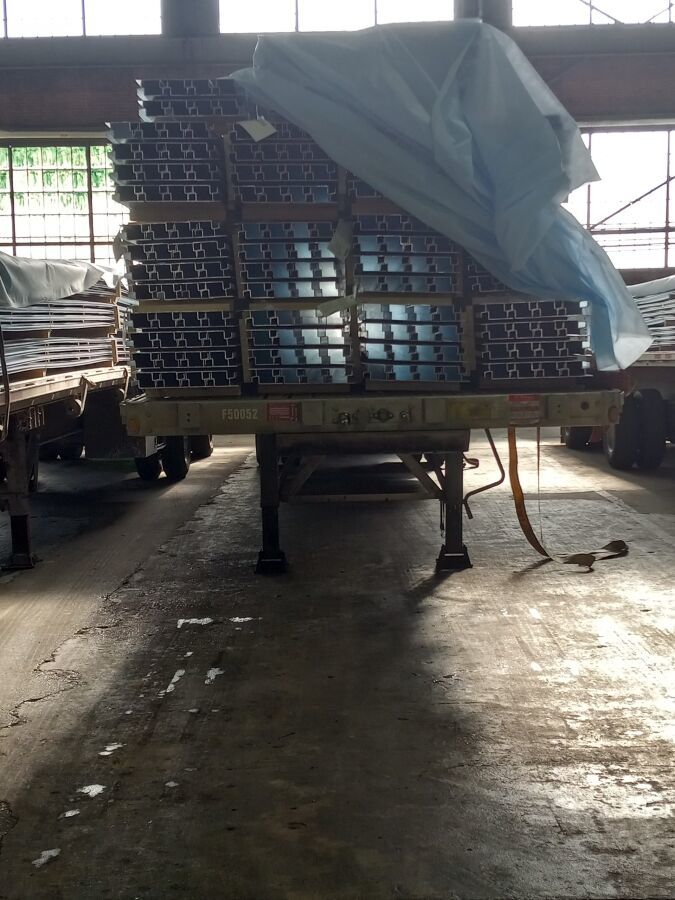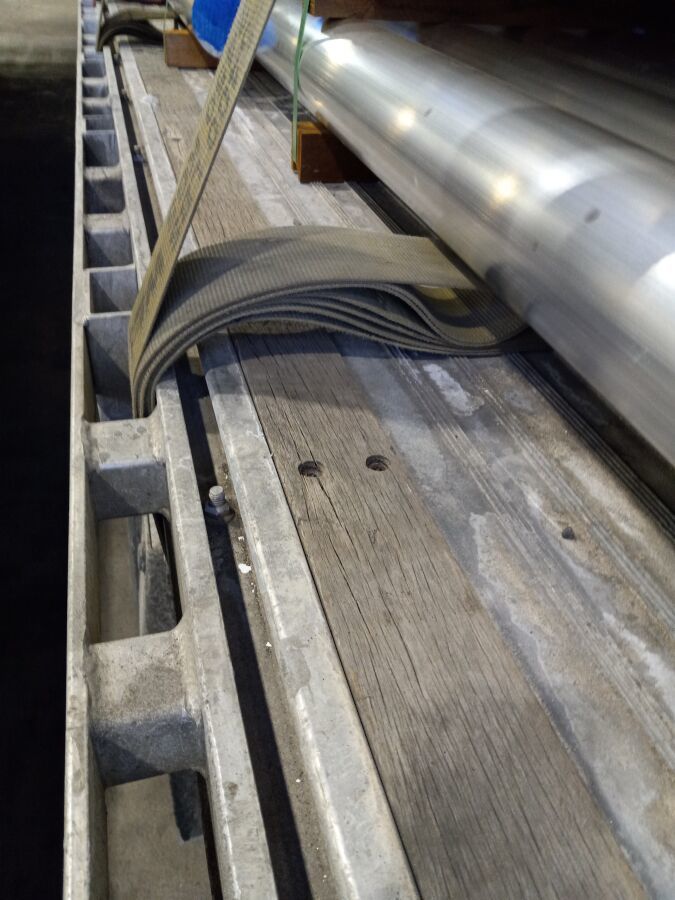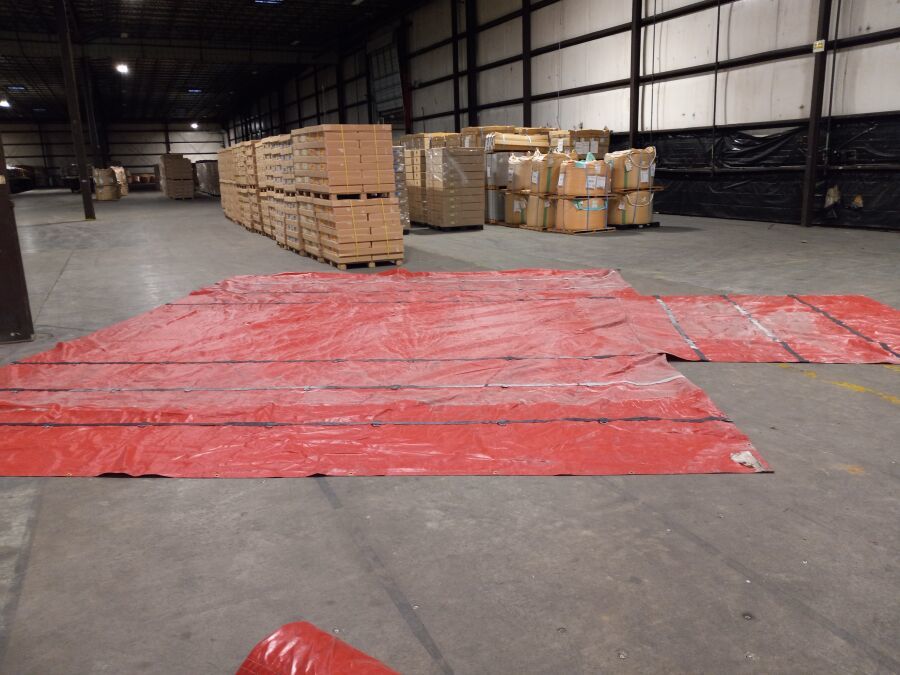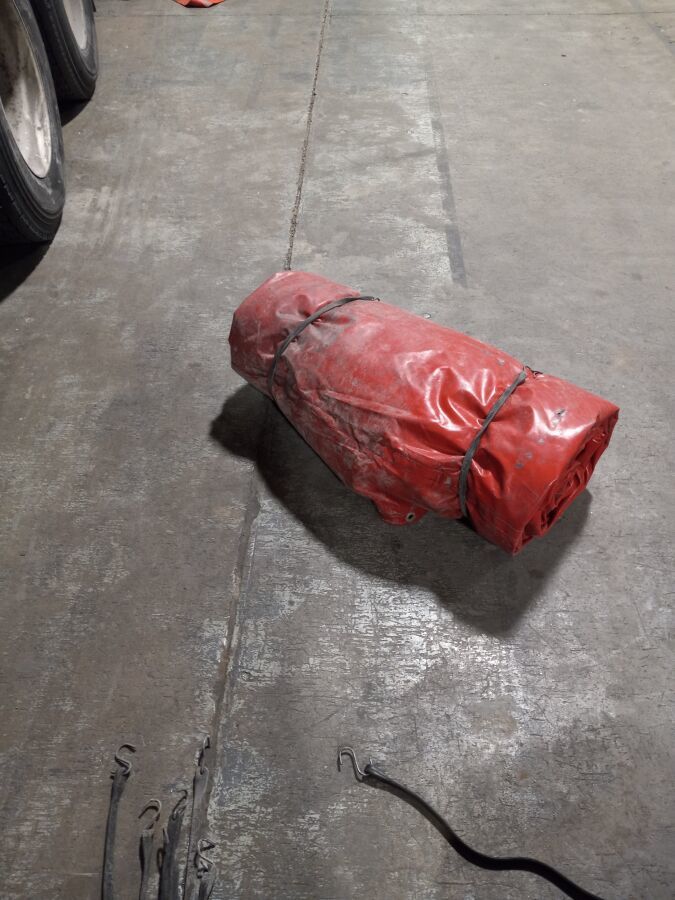First Year Solo. Knight Flatbed
Topic 31282 | Page 4
To answer your first question yes you can fold them the same way that you do the excess from a ratchet strap.
With regards to basic strapping I have a slightly different method depending on whether I have edge protection or not.
No matter what the first thing I do is get out everything that I need for securement. Let's take a simple load like shingles that has 9 rows total. I'll get out 11 straps and 22 vee boards. I use two straps on the front row, two straps on the back row, and one strap over each row in between.
I have a bag that I can carry about eight straps. I'll start at the driver's side and put the buckle in the driver's side rub rail and throw the strap over the front half of the first row of shingles. Then I alternate so I'll throw a strap over the 2nd row from the driver's side, the 4th Row from the driver's side, the 6th throw from the driver's side, the 8th row from the driver's side, and then one over the back row toward the front half. Then I go to the passenger's side and throw straps over the back half of the last row, the seventh row, the fifth row, the third row, and then the strap over the back half of the first row.
While I'm on the passenger side I will take the straps that I had thrown from the driver's side and just thread them through the rub rail and line up a winch underneath it. I do this primarily to prevent them from blowing around in the wind and then you got straps everywhere. Plus I've learned to make sure that I have straps and winches lined up where I need them. I've learned that if you just start throwing straps and put them through winches you realize pretty quick that you've thrown a strap and you don't have a winch available to put it through. I generally also put the excess winches in between my straps on each side in case when I'm looking at the load I think I need just one more strategically placed strap then I don't have to worry about having a winch for it. Then I go and grab all of my vee boards and put them underneath the straps.
Then I'll go along and hand tighten each strap in the winch and then grab my winch bar and tighten them down.
If I don't have any edge protection then when I go to the passenger's side after I finish throwing the straps over the from the driver's side I will hand tighten those straps while I'm throwing the other straps from the passenger's side.
I can strap a shingle load in about 30 minutes.
HOS:
Hours Of Service
HOS refers to the logbook hours of service regulations.OWI:
Operating While Intoxicated
Any updates on how things are going?
Any updates on how things are going?
Yes, updates.....
I received an email from Knight saying congratulations on 30 days solo. Didn't realize it's been 30 days. That went by quickly. I'm still having some growing pains in flatbed and have had some very frustrating days. Tarping a load is not my favorite part of this job lol. It takes me a while to tarp a load and even longer to un-tarp it. There is a lot of time spent at the shipper/receiver. "Or at least for me since I'm slow with tarping and strapping a load." I'm still adjusting to this type of work and finding different ways to become more productive.
The loads I get are not difficult, compared to other flatbed drivers I have it easy. But I still am second guessing myself and unsure of the loads I get. Last week I refused this load because it didn't seem right to me.
 I didn't like that it was leaning and I couldn't get the straps tight enough to my liking. I have hauled 3 loads like this so far and none of them were leaning, so this had me feeling uneasy. After talking with 2 drivers and members on this site, I was informed that the load would have been fine to take.
I didn't like that it was leaning and I couldn't get the straps tight enough to my liking. I have hauled 3 loads like this so far and none of them were leaning, so this had me feeling uneasy. After talking with 2 drivers and members on this site, I was informed that the load would have been fine to take.
My backing still needs work. There is little to no backing needed at the shipper/receiver, so I challenge myself and back into spots wherever I am, even when I am able to pull in. The frustrations are definitely building up but I'm just trying to take this one day at a time and learn each day.
I do enjoy driving so far. I noticed I have more stamina now than when I was in training. I am driving 10.5 to 11hrs a day. Also can drive for 7hrs straight before the mandatory 30min break. I do need to watch my clock better. Went into violation twice on my 11hr clock trying to push.
Shipper:
The customer who is shipping the freight. This is where the driver will pick up a load and then deliver it to the receiver or consignee.
TWIC:
Transportation Worker Identification Credential
Truck drivers who regularly pick up from or deliver to the shipping ports will often be required to carry a TWIC card.
Your TWIC is a tamper-resistant biometric card which acts as both your identification in secure areas, as well as an indicator of you having passed the necessary security clearance. TWIC cards are valid for five years. The issuance of TWIC cards is overseen by the Transportation Security Administration and the Department of Homeland Security.
OWI:
Operating While Intoxicated
Glad that you reached a company milestone with Knight.
Do yourself a favor and don't drive seven hours straight, as it's not good for the body. As a flatbedder, you need to be stopping more often to check on your load, anyway.
My backing still needs work. There is little to no backing needed at the shipper/receiver, so I challenge myself and back into spots wherever I am, even when I am able to pull in.
Backing practice: setup the reserved signs at Pilot or TA as if they were trucks so you can practice backing without consequence.
Shipper:
The customer who is shipping the freight. This is where the driver will pick up a load and then deliver it to the receiver or consignee.
I got a new truck earlier this month and am getting used to a KW again. Over the past week I've been doing at least half a dozen "practice backing maneuvers" each day to learn this truck's characteristics.
Continue to practice your backing whenever possible.
Glad that you reached a company milestone with Knight.
Do yourself a favor and don't drive seven hours straight, as it's not good for the body. As a flatbedder, you need to be stopping more often to check on your load, anyway.
Thanks PackRat, I should look at it in a more positive way. I overlooked the fact that I have now been 30 days solo. Doesn't seem like a milestone to me but it very much is. Also I do my 100 mile check and every 3 hr check when I'm loaded. I do seven hours driving when I'm empty, I agree it's not good for the body. I'm rushing to make it to the shipper before they close so I can get loaded and set up for the next day. I will try and work on that and plan accordingly. I would love to try out a KW. I'm in a International and the reverse is jumpy.
Thanks for the tip Chief, I usually practice with just the lines but setting up the signs like they are trucks would give me better visual points
Shipper:
The customer who is shipping the freight. This is where the driver will pick up a load and then deliver it to the receiver or consignee.
This week started out good. Monday I was able to do a 3 stop run in Ohio and deliver to each place before they closed. Tuesday I drove empty back to Cressona Pa and got loaded up. Took me less time to strap and tarp the load. A total of 4hrs for all instead of 4hrs just tarping lol. That included time talking with another Knight driver. Tarping that load went smooth, I was able to get into a rhythm and went step by step. No huge air bubbles in the tarp this time while I was driving. I watched and studied a video on YouTube of a guy from TMC tarping and that helped a lot. I also was able to fold the straps correctly like Chief Brody was explaining to me.
 Still have to practice not getting the fold in the winch but it worked out well.
Still have to practice not getting the fold in the winch but it worked out well.
The load went to Greenville, SC. A change from my usual route from PA to Indiana. I'm not complaining at all, dodged that winter storm in Ohio to come to beautiful 70 degree SC. I was able to deliver that load Thursday morning because they stop taking deliveries at noon and I made it there at 2pm Wednesday. From there did an empty run to Mount Holly SC for a pick up. Didn't get here before the shipping Dept. closed so I have to wait until 7am tomorrow to get loaded. Then back to Cressona....
Un-tarping a load is a headache. Taking the bungees off, then taking 3 tarps off, then folding them is rough! I would rather not tarp a load but it is what it is. I know for a fact this load I have to pick up has to be tarped smh. The real problem is there isn't a big enough area for me to work on folding the tarps. The only place that has enough space is in Lafayette Indiana. Plus it's indoors which is a plus...
 This is the place in Lafayette. The above pic is an end tarp. There are 2 of those and one middle tarp, which is the same as the end tarp minus the flap on the end. I have to fold them so they look like this:
This is the place in Lafayette. The above pic is an end tarp. There are 2 of those and one middle tarp, which is the same as the end tarp minus the flap on the end. I have to fold them so they look like this:
 3 of those, I think 8ft drop tarps. Heavy and dirty. Pain in the a$$$$$$!!!!!!
3 of those, I think 8ft drop tarps. Heavy and dirty. Pain in the a$$$$$$!!!!!!
After 30 days I'm just now starting to get into a rhythm with strapping and tarping a load. Backing still sucks though. Didn't get time to practice this week. Monday I parked at a rest area, no backing. Tuesday I stopped at the terminal after I got loaded, did a straight back. Wednesday night I gave up trying to park in between two trucks at a Pilot off of 85S and parked on the side. Today I'm in a parking lot at the shipper. Only had to do a U-turn and park along the side.
I feel like I'm really behind the game because of my lack of training. Trying not to be negative but everytime I get frustrated with parking, strapping or tarping it instantly pops in my head. I'm coming along though and this was the best week I had so far.
Shipper:
The customer who is shipping the freight. This is where the driver will pick up a load and then deliver it to the receiver or consignee.
Terminal:
A facility where trucking companies operate out of, or their "home base" if you will. A lot of major companies have multiple terminals around the country which usually consist of the main office building, a drop lot for trailers, and sometimes a repair shop and wash facilities.
DAC:
Drive-A-Check Report
A truck drivers DAC report will contain detailed information about their job history of the last 10 years as a CDL driver (as required by the DOT).
It may also contain your criminal history, drug test results, DOT infractions and accident history. The program is strictly voluntary from a company standpoint, but most of the medium-to-large carriers will participate.
Most trucking companies use DAC reports as part of their hiring and background check process. It is extremely important that drivers verify that the information contained in it is correct, and have it fixed if it's not.
HOS:
Hours Of Service
HOS refers to the logbook hours of service regulations.I don't know if it's possible for you with the way your routes and clocks are, but when I'm shutting down for the night I generally don't bother for any big name brand stops.
Occasionally a Petro will have enough spots but it's rare. I usually run til 3 am or so, that means almost all parking is full.
What I do instead is look for older hole in the wall truck stops. I'll look on my Garmin, and on Truckerpath before I start. Also just use my eyes. Most of the time they have many Open spots and it's usually old school drivers that are there. Then in the morning during my first break, I'll hit a loves or pilot for the shower when it's mostly empty and clean.
Again, I don't know if that's possible for you. But it works for me.
New Reply:
New! Check out our help videos for a better understanding of our forum features

















Preview:
This topic has the following tags:
Knight Transport Advice For New Truck Drivers Backing Challenges Driver Responsibilities Flatbed Load Securement Truck Driver Training







 TT On Facebook
TT On Facebook
Also my truck still pulls to the right, the vibration in the steering wheel is gone though.....